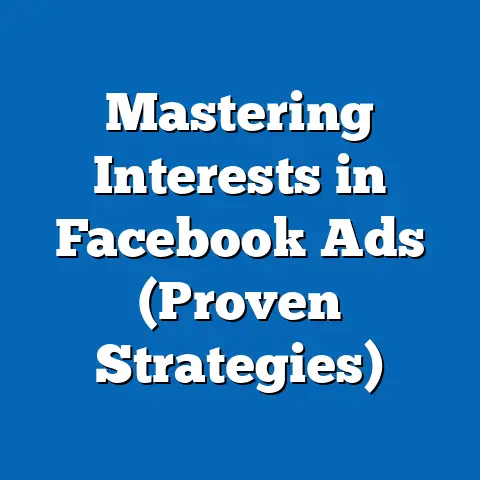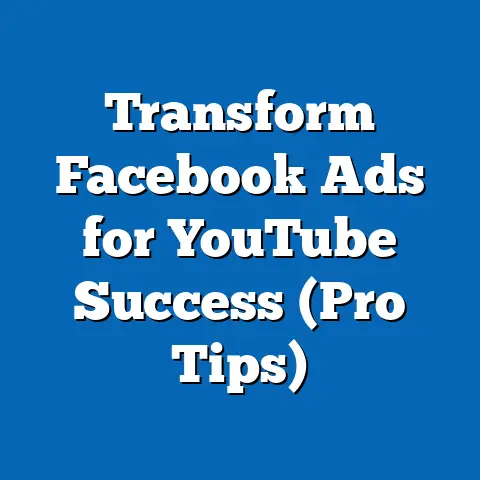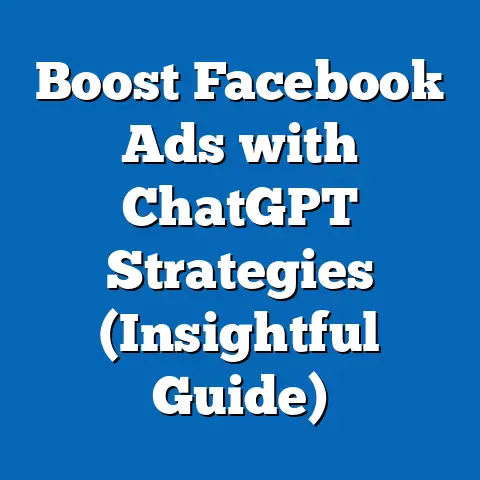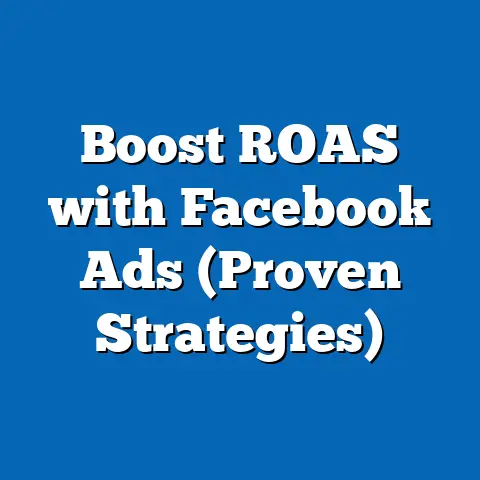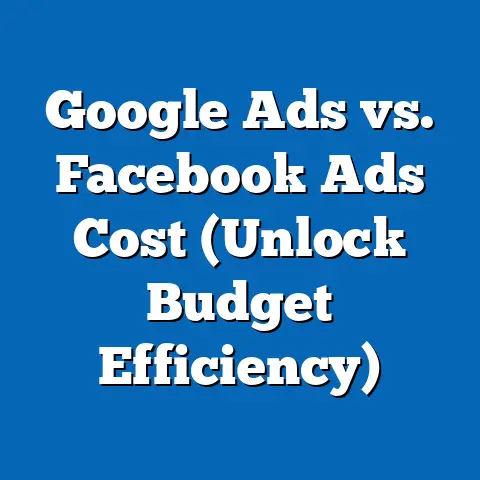Elevate Strategy: Transform Facebook Ads (Future Trends)
Do you remember the early days of Facebook advertising? It feels like a lifetime ago, doesn’t it? I remember when it was all about boosting posts to your friends and family, a simple way to share your business with your immediate circle. The targeting was basic, but the excitement was palpable. It was thrilling to see likes and comments rolling in, a direct connection with your audience that felt revolutionary. Those early experiences, though primitive by today’s standards, laid the groundwork for the complex and powerful advertising platform Facebook has become.
Now, as we look ahead, the landscape is shifting again. Technological advancements, evolving consumer behaviors, and innovative strategies are reshaping the future of Facebook ads. Brands need to adapt and elevate their strategies to not just survive, but thrive. This isn’t just about keeping up; it’s about anticipating what’s next and positioning yourself for success. In this article, I’ll guide you through the evolution of Facebook ads, explore current trends, peek into the future, and provide actionable insights to transform your Facebook ad strategy.
The Evolution of Facebook Ads
The journey of Facebook ads has been nothing short of remarkable. It started with simple banner ads and boosted posts, a far cry from the sophisticated targeting and creative options we have today. In the beginning, it was more about visibility than precision. But as Facebook’s user base exploded, so did its potential as an advertising platform.
One of the key milestones was the introduction of targeted advertising. Suddenly, businesses could reach specific demographics, interests, and behaviors. This was a game-changer, allowing for more relevant and effective ad campaigns. I remember the first time I used detailed targeting – it felt like unlocking a secret weapon! The ability to pinpoint your ideal customer with such accuracy was unprecedented.
The shift to mobile-first strategies was another pivotal moment. As smartphones became ubiquitous, Facebook recognized the importance of optimizing ads for mobile devices. This led to the development of new ad formats, like video ads and mobile app install ads, designed to capture attention on smaller screens.
And then came video. The rise of video content on Facebook revolutionized advertising. Engaging visuals, compelling storytelling, and the power of autoplay made video ads incredibly effective. I’ve seen firsthand how a well-crafted video ad can drive engagement, brand awareness, and conversions.
Throughout this evolution, user behavior has been a driving force. Consumers have become more discerning, more demanding, and less tolerant of irrelevant or intrusive advertising. This has made personalization and relevance more important than ever.
Takeaway: Understanding the history of Facebook ads helps you appreciate the platform’s current capabilities and anticipate future changes. It’s a reminder that adaptation is key to success.
Current Trends Shaping Facebook Advertising
The Facebook advertising landscape is constantly evolving, driven by a number of key trends. Understanding these trends is crucial for staying ahead of the curve and maximizing your advertising ROI.
AI and Machine Learning
One of the most significant trends is the increasing use of artificial intelligence (AI) and machine learning (ML) for ad optimization. Facebook’s algorithms are becoming more sophisticated at analyzing data, identifying patterns, and predicting which ads are most likely to perform well. This allows for automated bidding, targeting, and creative optimization, freeing up marketers to focus on strategy and creative development.
I’ve seen firsthand how AI can improve ad performance. For example, Facebook’s Advantage+ campaign budget, which uses machine learning to allocate budget across ad sets, can significantly improve results compared to manual budget allocation. It’s like having a smart assistant constantly analyzing and optimizing your campaigns.
Data Privacy
Data privacy is another major trend shaping Facebook advertising. In response to growing concerns about data security and privacy, Facebook has implemented stricter regulations and policies. This has made it more challenging to target specific audiences and track ad performance.
However, it has also created opportunities for more ethical and transparent advertising practices. Brands that prioritize data privacy and build trust with their customers are more likely to succeed in the long run.
Ephemeral Content
The rise of ephemeral content, like Stories and Reels, is also impacting Facebook advertising. These short-form, engaging video formats are becoming increasingly popular with users, especially younger audiences.
Brands are leveraging Stories and Reels to create authentic, relatable content that captures attention and drives engagement. I’ve found that behind-the-scenes content, product demos, and interactive polls work particularly well in these formats.
Social Commerce
Social commerce is another trend transforming Facebook advertising. Facebook’s shopping features allow brands to sell products directly from their ads, making it easier for consumers to make purchases without leaving the platform.
This is particularly effective for e-commerce businesses that want to streamline the buying process and reduce friction. I’ve seen businesses double their conversion rates by enabling shopping features in their Facebook ads.
Influencer Marketing
Finally, influencer marketing continues to be a powerful force within Facebook’s ecosystem. Partnering with influencers who have a strong following and a trusted voice can help brands reach new audiences, build credibility, and drive sales.
The key is to find influencers who align with your brand values and target audience. Authenticity is crucial – consumers are more likely to trust recommendations from influencers they believe in.
Takeaway: Staying informed about current trends in Facebook advertising is essential for adapting your strategies and maximizing your ROI. Embrace AI, prioritize data privacy, leverage ephemeral content, explore social commerce, and consider influencer marketing.
Future Trends in Facebook Advertising
Looking ahead, the future of Facebook advertising is likely to be shaped by several key trends, including advancements in augmented reality (AR) and virtual reality (VR), greater integration with other platforms, and a growing emphasis on sustainability and social responsibility.
Augmented Reality (AR) and Virtual Reality (VR)
Augmented reality (AR) and virtual reality (VR) are poised to revolutionize the way brands create and deliver ad experiences. AR ads allow users to interact with virtual objects in the real world, creating immersive and engaging experiences. For example, a furniture retailer could allow users to see how a sofa would look in their living room using AR.
VR ads, on the other hand, transport users to entirely new virtual environments. This could be used to create interactive product demos, virtual tours, or immersive brand experiences. I believe that AR and VR will become increasingly important for brands looking to stand out from the crowd and create memorable ad experiences.
Platform Integration
Greater integration with other platforms, like Instagram and WhatsApp, is another trend to watch. Facebook owns these platforms, and it is likely that we will see even greater integration in the future. This could include cross-platform advertising, shared audiences, and seamless data sharing.
This would allow brands to create more cohesive and consistent customer experiences across multiple touchpoints. For example, a brand could target users on Facebook and then retarget them on Instagram with a different ad message.
Sustainability and Social Responsibility
Finally, sustainability and social responsibility are becoming increasingly important to consumers. Brands that demonstrate a commitment to these values are more likely to attract and retain customers.
This means that brands need to be transparent about their environmental impact, ethical sourcing practices, and social initiatives. They also need to ensure that their advertising is not misleading or harmful. I believe that sustainability and social responsibility will become a key differentiator for brands in the future.
Takeaway: Prepare for the future of Facebook advertising by exploring AR and VR, embracing platform integration, and prioritizing sustainability and social responsibility.
Elevating Your Facebook Ad Strategy
So, how can you elevate your Facebook ad strategy in response to these trends? Here are some actionable insights:
Test and Iterate Ad Creatives
Continuously test and iterate your ad creatives. Experiment with different formats, messaging, and visuals to see what resonates best with your target audience. Use A/B testing to compare different versions of your ads and identify the most effective elements.
I recommend testing at least one new ad creative per week. This will help you stay ahead of the curve and avoid ad fatigue.
Utilize Advanced Targeting Techniques
Take advantage of Facebook’s advanced targeting techniques. Use detailed targeting, custom audiences, and lookalike audiences to reach the right people with the right message.
Don’t be afraid to experiment with different targeting options. You might be surprised at what works.
Harness Data Analytics
Harness data analytics for informed decision-making. Track your ad performance metrics, like reach, engagement, and conversions, to understand what’s working and what’s not. Use this data to optimize your campaigns and improve your ROI.
I recommend using Facebook Analytics to track your ad performance. This tool provides a wealth of data that can help you make informed decisions.
Stay Agile and Adaptable
Stay agile and adaptable in an ever-changing landscape. Facebook is constantly evolving, so it’s important to stay up-to-date on the latest features, policies, and best practices.
Attend industry conferences, read blogs, and follow thought leaders to stay informed. And don’t be afraid to experiment with new strategies and tactics.
Embrace Continuous Learning
Embrace continuous learning and innovation. The world of Facebook advertising is constantly changing, so it’s important to be a lifelong learner.
Take online courses, attend workshops, and read books to expand your knowledge. And don’t be afraid to try new things.
Takeaway: Elevating your Facebook ad strategy requires continuous testing, advanced targeting, data-driven decision-making, agility, and a commitment to learning.
Conclusion
The future of Facebook advertising is bright, but it requires a proactive approach. By understanding the evolution of the platform, embracing current trends, and preparing for future changes, you can elevate your Facebook ad strategy and achieve your business goals.
Remember those early days of Facebook advertising? The simplicity, the excitement, the direct connection with your audience? While the platform has become more complex, the core principles remain the same: relevance, engagement, and value.
As you move forward, embrace change, experiment with new strategies, and never stop learning. The future of Facebook advertising is an exciting opportunity for growth and engagement. Take proactive steps towards elevating your strategies for success, and you’ll be well-positioned to thrive in the ever-evolving world of digital marketing.

